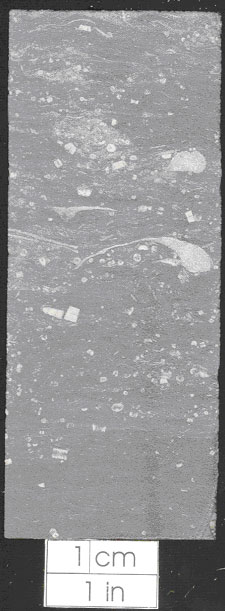 |
|
Kansas Geological Survey Open-file Report 2003-82 |
2.1.9 Dark Gray Shale Facies
Description
Diagnostic features of the dark gray shale facies include thin laminations
(3 mm), fissility, parallel bedding, and minor amounts of quartz silt. The
facies is dark gray to black changing gradually upwards to medium gray (Figure
2.11). Minor amounts of clay ironstone (cf. siderite) or pyrite nodules are
observed in the middle to upper portion of the facies. Identified fossils,
when present, include small fragments of brachiopods, fusilinids and crinoids.
Fossil shells are commonly concave down and fossil material is concentrated
in thin layers that are normally graded. The dark gray shale facies ranges
in thickness from 10 to 15 feet (3 to 4.5 m). Upper and lower contacts of
the dark gray shale facies are gradational.
Paleoenvironmental Interpretation
The parallel laminated shale indicates sediment fallout in a low energy environment
possibly deep marine with little bioturbation. A gradual change from dark
gray upward to light gray color indicates a change from anaerobic to more
aerobic conditions. Thin intervals of normally graded and concave downward
bioclastic fragments (5-10 cm) may represent higher energy storm deposits
that are periodically introduced into offshore deeper water environments.
The presence of minor amounts of pyrite and siderite in the upper portion
of the facies also suggests the influence of freshwater and shift to aerobic
conditions. This lithofacies is interpreted as a offshore transitional environment.
Historically, the dark gray shale facies would be interpreted as part of the
“core shale” in the cyclothem model.
 |
| Figure 2.11 - Polished core section showing dark gray shale facies. Note small scattered fossil fragments and absence of bioturbation. Sample from 713' in the Hinthorn CW#1 well, 14-T32S-R16E, Montgomery County, Kansas |
e-mail : webadmin@kgs.ku.edu
Last updated December 2003
http://www.kgs.ku.edu/PRS/publication/2003/ofr2003-82/chapter2_9.html